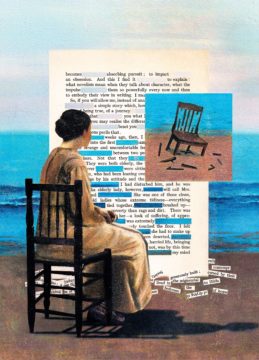Parul Sehgal in The New Yorker:
 It was on a train journey, from Richmond to Waterloo, that Virginia Woolf encountered the weeping woman. A pinched little thing, with her silent tears, she had no way of knowing that she was about to be enlisted into an argument about the fate of fiction. Woolf summoned her in the 1924 essay “Mr. Bennett and Mrs. Brown,” writing that “all novels begin with an old lady in the corner opposite”—a character who awakens the imagination. Unless the English novel recalled that fact, Woolf thought, the form would be finished. Plot and originality count for crumbs if a writer cannot bring the unhappy lady to life. And here Woolf, almost helplessly, began to spin a story herself—the cottage that the old lady kept, decorated with sea urchins, her way of picking her meals off a saucer—alighting on details of odd, dark density to convey something of this woman’s essence.
It was on a train journey, from Richmond to Waterloo, that Virginia Woolf encountered the weeping woman. A pinched little thing, with her silent tears, she had no way of knowing that she was about to be enlisted into an argument about the fate of fiction. Woolf summoned her in the 1924 essay “Mr. Bennett and Mrs. Brown,” writing that “all novels begin with an old lady in the corner opposite”—a character who awakens the imagination. Unless the English novel recalled that fact, Woolf thought, the form would be finished. Plot and originality count for crumbs if a writer cannot bring the unhappy lady to life. And here Woolf, almost helplessly, began to spin a story herself—the cottage that the old lady kept, decorated with sea urchins, her way of picking her meals off a saucer—alighting on details of odd, dark density to convey something of this woman’s essence.
Those details: the sea urchins, that saucer, that slant of personality. To conjure them, Woolf said, a writer draws from her temperament, her time, her country. An English novelist would portray the woman as an eccentric, warty and beribboned. A Russian would turn her into an untethered soul wandering the street, “asking of life some tremendous question.”
How might today’s novelists depict Woolf’s Mrs. Brown? Who is our representative character? We’d meet her, I imagine, in profile or bare outline. Self-entranced, withholding, giving off a fragrance of unspecified damage. Stalled, confusing to others, prone to sudden silences and jumpy responsiveness. Something gnaws at her, keeps her solitary and opaque, until there’s a sudden rip in her composure and her history comes spilling out, in confession or in flashback. Dress this story up or down: on the page and on the screen, one plot—the trauma plot—has arrived to rule them all. Unlike the marriage plot, the trauma plot does not direct our curiosity toward the future (Will they or won’t they?) but back into the past (What happened to her?). “For the eyeing of my scars, there is a charge,” Sylvia Plath wrote in “Lady Lazarus.” “A very large charge.” Now such exposure comes cheap.
More here.
